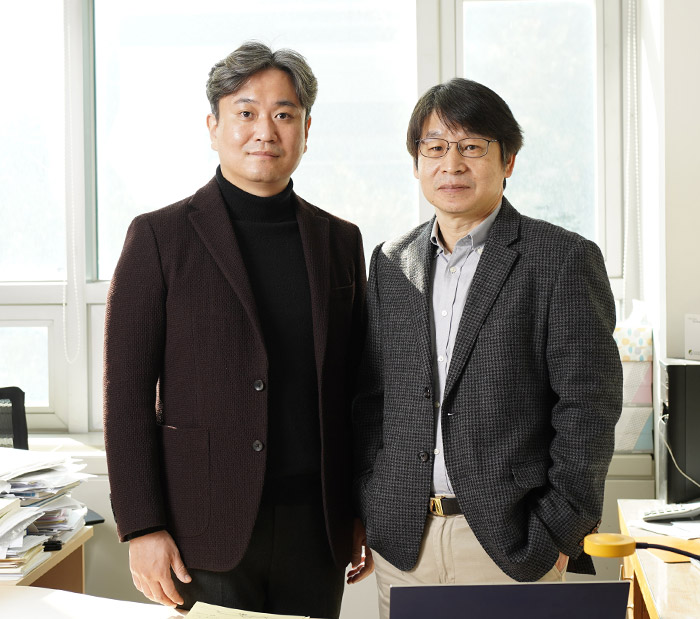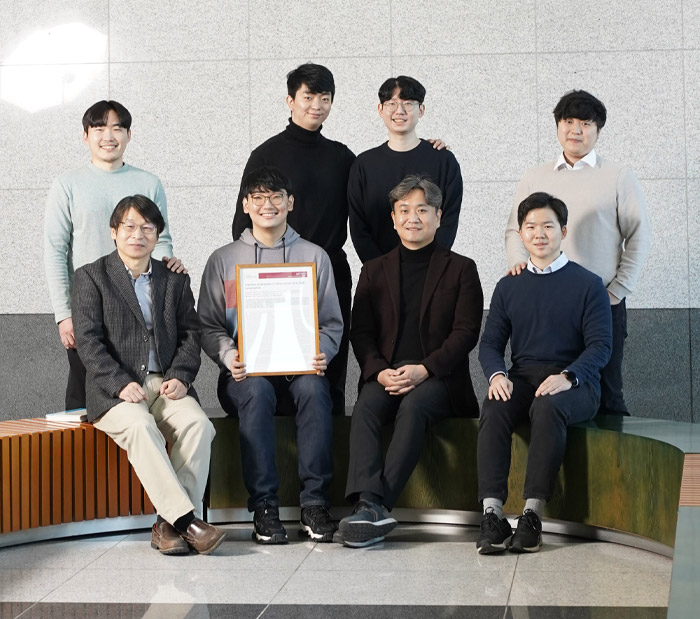Research Stories
Presents an approach to a control by steering dipole densities at the interface of III-V–II-VI h-NCs
Presents an approach to control new characteristics and porperties of III-V quantum dot for the future
SKKU Advanced Institute of Nano Technology
Prof.
BAE, WANKI
Prof. Euyheon Hwang
Heterostructured nanocrystals (h-NCs), in which multiple nanoscale semiconductor domains are interconnected via bonding interfaces, are new classes of luminophores that stand at the forefront of nearly all light-emitting applications. The success of h-NCs is attributed to the controllability and the tunability of the electronic structure and the spatial distribution of charge carriers in h-NCs. Such changes are emergent collective responses to the dimension and the composition of h-NCs, which define the potential profile at the interface of h-NCs and consequently the photophysical and photochemical characteristics of h-NCs.
Everyday light-emitting applications call for the research to understand and manipulate heavy metal-free h-NCs, which are formulated with the combinations of III-V and II-VI compounds (e.g., InP/ZnSe or ZnS h-NCs). However, the limited material choice for III-V/II-VI h-NCs deters the access to one of the external knobs for the control of the potential landscape of h-NCs. The quantum confinement effect allows marginal success in controlling the optical bandgap of III-V/II-VI h-NCs, but the customized potential profile has considered to be unavailable. This constrains the envelopment of materials functions including the recombination dynamics and transport characteristics of charge carriers that are keys to the success of optical and optoelectronic applications implementing h-NCs.
In the present study, the team of Prof. Wan Ki Bae and Prof. Euyheon Hwang of SKKU advanced institute for Nanotechnology (SAINT) provide an unprecedented approach to tailor the potential landscape of heavy metal-free III-V/II-VI h-NCs on demand. The present research stems from our discovery that the heterovalent bonding at the interface, which exists inevitably in the formation of III-V/II-VI interfaces, is an additional knob that changes the potential profile of III-V/II-VI h-NCs. Spectroscopic analysis in chorus with quantum mechanical calculation and density functional theory calculation show that the interfacial polarization by the heterovalency at the interface is responsible for the vacuum level shift that alters the potential profile across III-V/II-VI h-NCs.
In addition to the findings, the team devise an effective chemical means to control the stoichiometry at the III-V/II-VI interfaces with atomic precision. The interfacial dipole intensity enables to adjust the band positions of III-V cores on demand by an extent of ca. 400 meV at the given geometry of InP/ZnSe h-NCs, which accompanies the changes in their electronic energy levels, the spatial distribution of charge carriers and their recombination dynamics, and the transport characteristics of charge carriers across h-NCs. A comprehensive study on III-V/II-VI h-NCs of varying compositional combinations (i.e., InP/ZnSe, InP/ZnS, InAs/ZnSe, In0.5Ga0.5P/ZnSe, In0.3Ga0.7P/ZnS, and InP/CdS h-NCs) is conducted to comprehend the structural-property relationship quantitatively and to validate the impact experimentally.
Furthermore, the team capitalize on the atomic precision with which to synthesize h-NCs by correlating interfacial dipole moments to photochemical stability and optoelectronic performance of resulting h-NCs. The customized potential profile in h-NCs promises to engineer the transport characteristics of charge carriers across h-NCs to environments, enabling us to enhance the photochemical stability of h-NCs against the external stress and the optoelectronic performance of h-NCs in light-emitting diodes close to the theoretical limit (EQE ~ 18.5 %). The present study implies that, together with the quantum confinement effect, the capability of engineering the structural characteristics of the heterovalent interface allows one to customize the potential profile of heavy metal-free III-V/II-VI h-NCs that overcome the limitation of materials choice, and hence fosters the practical use of h-NCs in a variety of light-emitting applications.
This work was supported by the National Research Foundation of Korea (NRF) grant funded by the Ministry of Science, ICT, and Future Planning (2020R1A2C2011478, 2021M3H4A3A01062964, 2020M3D1A2101319, and 2021M3H4A1A01004332), and Electronics and Telecommunications Research Institute (ETRI) grant funded by the Korean government (No. 20ZB1200, Development of ICT Materials, Components and Equipment Technologies). This research was also supported by Samsung Display.
※Title: Interface polarization in heterovalent core/shell nanocrystals


